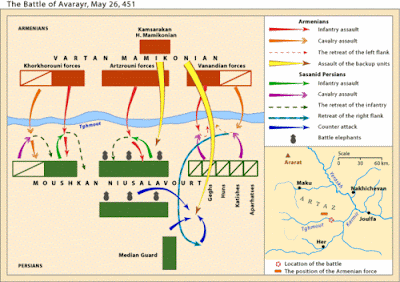Vahe H. Apelian
Several years ago in February, I attended a banquet in Burbank, California. It was organized by the local chapter of the Knights of Vartan. The event was to honor noted Armenian educators in the Greater Los Angeles area. Gabriel Injejikian had invited me to join him and his family as their guest. He was. one of the honorees.
In his opening remarks, the master of ceremonies stated that Armenians know how to make a moral victory out of defeat citing the feast of St. Vartanants. Armenians have been celebrating the feast for over 1,500 years. This popular misconception is rooted in the protracted war Armenians fought against the Persian in the 5th century to retain their right to worship their Christian religion. Instead of dwelling on the outcome of the war, that struggle has been symbolically focused on the fallen commander-in-chief Vartan Mamigionian and his combatants in the battle he lost. The battle, fought in 451 AD, is named after the plain on which it was waged and has come to be known as the Battle of Avarayr. It was the first and major military confrontation of that protracted war known as the Vartanian War (Vartanants Baderazm).
“Though beaten, however, the Armenian army was far from destroyed,” wrote Dr. Antranig Chalabian in an article in the Military History magazine noting that: "Vahan Mamikonian, son of the great Vardan's brother Hmayak, took charge and led the Armenians in a guerrilla war that flared around strongholds and along impregnable heights for the next 33 years.
During that time, the Sassanids underwent three changes of rulers, and also had to deal with external conflicts with Rome and a new wave of eastern barbarians known as the Ephthalites, or White Huns. The Persian king Balash, reassessed the long, inconclusive conflict against the Armenians and sued for peace."
Vahan sent messengers to the Persian camp, with proposals for “religious worship in accordance with Christian doctrines and rites to be declared free in Armenia, and fire altars to be removed”. Balash accepted the terms Vahan Mamigonian dictated. In 484 the two parties signed a treaty in the village of Nvarsag conceding to the Armenians the objectives of the war. The treaty came to be known after the village where it was signed. Historians claim that it is the first treaty of its kind. THE ARMENIANS HAD PREVAILED having secured the objectives of the war, although they had lost its first major battle.
It is AFTER the signing of the treaty, the succesful conclusion of the war was celebrated in the Cathedral of Dvin. Catholicos Hovhan I Mandakuni (478¬490) officiated the ceremony with the dynastic lords in attendance and has been celebrated since. it is the conclusion of the war that secured the Armenians the rights to worship their Christian religion we celebrate to this day.
Vartan Mamigonian hailed from royalty. He was the grandson of Catholicos Saint Sahag, a descendent of Saint Gregory the Illuminator. It is up to historians and ecclesiastical fathers to shed light as to why the Armenian Church opted to canonize only the participants of the Battle of Avarayr and raise to sainthood its commander-in-chief Vartan Mamigonian, its fiery priest Ghevont Yerets and the fallen combatants of the battle but not also Vahan Mamigonian and his combatants who continued the war to its successful conclusion. The Feast of Vartanants is commemorated in February on the Thursday preceding Great Lent. It is both a religious and patriotic feast.
The Battle of Avarayr was surely the major military confrontation of that long protracted war. Eghishé, a contemporary chronicler, described the Battle of Avarair, to which he was an eyewitness as follows: "One should have seen the turmoil of the great crisis and the immeasurable confusion on both sides, as they clashed with each other in reckless fury. The dull-minded became frenzied; the cowards deserted the fields; the brave dashed forward courageously, and the valiant roared. They attacked each other fiercely and many on both sides fell wounded on the field, rolling in agony."
The priest-historian broke down the 1,036 Armenian killed in the Battle of Avarayr as follows:
House of Mamigonyan, Brave Vartan and 133 warriors (Մամիկոնեան Տոհմէն՝ Քաջն Վարդան եւ 133 մարտիկներ).
House of Balounyats, Valiant Ardag and 57 warriors (Պալունեանց Տոհմէն՝ Արի Արտակը եւ 57 մարտիկներ).
House of Khorkhorounyats, Skillful-in-Arms Khoren and 19 warriors (Խորխոռունեաց Տոհմէն՝ Կորովի Խորենը եւ19 մարտիկներ).
House of Kntounyats, Admirable Dajad and 19 warriors (Գնդունեաց Տոհմէն՝ Զարմանալի Տաճատը եւ 19 մարտիկներ).
House of Timaksyan, Wise Hmayag and 22 warriors (Դիմաքսեան Տոհմէն՝ Իմաստուն Հմայեակը եւ 22 մարտիկներ).
House of Katchperounyats, Builder Nerses and 7 warriors (Քաջբերունեաց Տոհմէն՝ Հրաշակերտ Ներսեսը եւ 7 մարտիկներ).
House of Knounyats, Manoug Vahan and 3 warriors, (Գնունեաց Տոհմէն՝ Մանուկ Վահանը ե 3 մարտիկներ).
House of Enzaynots, Just Arsen and 7 warriors, (Ընծայնոց Տոհմէն Արդար Արսէնը եւ 7 մարտիկներ).
House of Srouantsdiants, Enlightened Karekin and 2 of his family members, (Սրուանձտեանց Տոհմէն՝ Յառաջադէմ Տարեգինը իր 2 հարազատներով).
Nine major lords along with combatants from Artzrounyats (Արձրունեաց) and other dynastic houses were martyred at the Battle of Avarayr.
As to the reason we celebrate the war in February when the war actually took place in May, I quote Dr. Antanig Chalabian: “The Vardanian War, as it came to be called in Vardan's honor, began on May 26, 451, but the Armenian church celebrates the event in February. In the past, spring was considered the season for warfare. Armenia's ecclesiastical fathers had decided to commemorate the event in February, before spring, in order to inspire the youth and prepare their minds for battle, in defense of church and fatherland.”



No comments:
Post a Comment